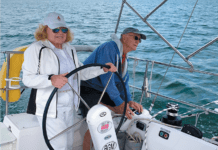From Bob Bonds The Handbook of Sailing
Rafting up is the term given to berthing alongside another boat (or boats), whether next to piles, a pier, a float or a mooring. It is not an ideal way of berthing because if a boat on the inside of a raft wishes to leave first it causes considerable inconvenience. Another disadvantage to rafting up is that the crews of the boats in the raft will have to cross other boats to get to and from the shore.
In a crowded harbor, however there is often no choice. There are certain precautions you should take before rafting up. Try and find out if the harbor limits the number of boats in a raft. If there is someone on board the boat you are rafting up to, ask permission first. You need to make sure that your lines are long enough to secure your bow and stern to the permanent fixing- float, pier, or whatever- if you find yourself either in tidal waters or on the outside of a raft of several boats. Try and avoid a raft where only the inside boat is secured to the pier or piles- such a raft will swing backwards and forwards making your stay uncomfortable.
It also helps to minimize swaying motion if you raft up alongside a boat larger than your own. You always need to make sure the masts are staggered; if adjacent, and the boats roll, the rigging may be fouled.
As a matter of common courtesy, always walk forward of the mast when crossing over other boats- it helps preserve privacy.
For more advice and tips on everything from boat maintenance, navigation, racing tactics and cruise planning, purchase Bob Bonds The Handbook of Sailing. This classic contains 2,000 diagrams and photos enabling you to visualize every sailing procedure and maneuver; reflects the latest word on procedures, techniques, and equipment.





































